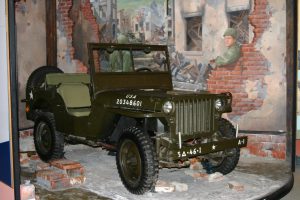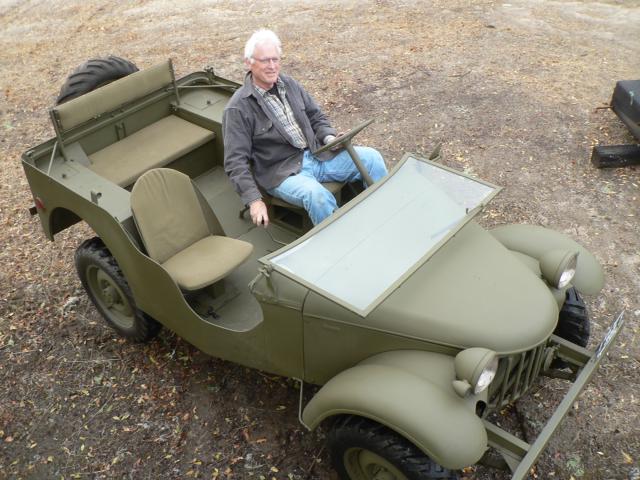 It is often mentioned that General Marshall considered the jeep one of the best, if not the best, weapons of the war. More intriguing, but still lacking complete detail, have been suggestions that he had something specifically to do with the creation of the original jeep. The evidence today seems to suggest the conclusion that he probably didn’t have a great deal to do with the particular conception of the vehicle itself, but without Marshall’s leadership and determination to get things moving and to develop decision-making subalterns, the jeep, as we know it, may never have been built at all or certainly would have appeared much later.
It is often mentioned that General Marshall considered the jeep one of the best, if not the best, weapons of the war. More intriguing, but still lacking complete detail, have been suggestions that he had something specifically to do with the creation of the original jeep. The evidence today seems to suggest the conclusion that he probably didn’t have a great deal to do with the particular conception of the vehicle itself, but without Marshall’s leadership and determination to get things moving and to develop decision-making subalterns, the jeep, as we know it, may never have been built at all or certainly would have appeared much later.
The original jeep was the creation of the American Bantam Car Company that during the 1930’s had produced but failed to sell Americans on the idea of the small, second car, a market eventually exploited by Volkswagen. By 1940, the Company was on its last legs and had hired a Washington sales rep, one Charles H. “Harry” Payne to look around for contract work such as manufacturing aircraft parts to keep the factory busy. Payne had no portfolio to sell the Army the Bantam car, nor did he have any actual plans for such a car which, given the performance requirements, was probably not even possible to build.
The Army had tried Austin and later Bantam Cars and was intrigued with the small size and weight, but, they were barely powerful enough for civilian use let alone battlefield conditions. They needed four-wheel drive and more power to drive them. Neither Bantam nor the Army had R&D money for such a thing.
Payne turned out to be something of a one-man hurricane and began a campaign of “knocking on doors” all over Washington trying to convince someone of the need for a little Bantam battle wagon to replace the motorcycle, horse and half-ton truck for reconnaissance work. Described variously as an “obnoxious pest” to the “Father of the Jeep,” Payne left a lot of sore toes among the procurement service “brass hats” who were unenthusiastic about his little hot rod. Indeed, it was at this point what we would call pure vaporware. Among the using arms Payne was something of a hero, and with Infantry now behind him, he ignored the chain of command and went wherever he needed to go to sell his car.
 Payne wound up convincing the about-to-retire Secretary of War Harry Woodring on the concept, and Woodring started Payne on a round of appointments that led through Robert Patterson’s office to Marshall’s where he was received by Marshall’s aide, Major (not Major General!) Walter Bedell Smith. Smith liked the idea and took it to Marshall who had developed his aide to make and act on decisions. Smith takes the ball and runs with it.
Payne wound up convincing the about-to-retire Secretary of War Harry Woodring on the concept, and Woodring started Payne on a round of appointments that led through Robert Patterson’s office to Marshall’s where he was received by Marshall’s aide, Major (not Major General!) Walter Bedell Smith. Smith liked the idea and took it to Marshall who had developed his aide to make and act on decisions. Smith takes the ball and runs with it.
From that point Payne had a powerful ally and is able to get an Ordnance Subcommittee appointed to visit the Bantam home in Butler, Pennsylvania. Taking the Army requirements in hand, Bantam is able, almost miraculously to make good on Payne’s vague promises of a wonder car, and in 49 days a race car builder, Harold Crist and his assistant, a Butler watch maker produce the jeep, a weapon that was immediately recognized as a tactics-changing weapon of enormous significance. It is one of the most interesting and exciting stories in automotive history.
About Bill Spear
Bill Spear is a graduate of the Georgetown Univ. School of Foreign Service, the Nebraska College of Law and for nearly fifty years has been a resident of Juneau, Alaska. Reversing fields completely from a successful legal career during Alaska’s oil development years, Spear combined his life-long penchant for drawing and painting with enterprise and established “Wm Spear Design.” Then an innovative “information age” business, it still thrives 35 years later and is known internationally in museum shops and galleries for his personally designed line of enamels. Besides art, Spear has actively indulged his many other interests and avocations including natural history, writing, politics and the restoration of old cars which led him to become president of the Austin Bantam Society and write the soon-to-be-published jeep book, WARBABY: The True Story of the Original Jeep, which has been called by early readers the definitive authority on this often confused subject.
NOTE: Plan now to attend Bill’s presentation on the “The True Story of the Early Jeep” on Wednesday, October 12, 2016. RSVP early!
